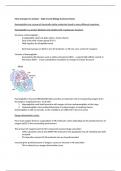Summary
Summary Notes on Mass Transport in Animals - AQA A Level Biology
- Institution
- AQA
Summary Notes on Mass Transport in Animals - AQA A Level Biology A* and A quality Detailed notes with diagrams Tailored vocabulary towards mark schemes with key marking points bulleted AQA specific - mark schemes used to make notes specific
[Show more]



